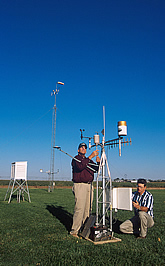This page has been archived and is being provided for reference purposes only. The page is no longer being updated, and therefore, links on the page may be invalid.
New Soil Moisture Sensors Assessed
By Don ComisFebruary 23, 2007
Five years of trials around the world have conclusively shown the strengths and weaknesses of commercial soil moisture sensors used for irrigation.
Steven R. Evett, a soil physicist with the Agricultural Research Service (ARS) Soil and Water Management Research Unit in Bushland, Texas, and colleagues had a major role in the research, which was sponsored by the Food and Agriculture Organization of the United Nations and the International Atomic Energy Agency.
The Bushland researchers found that only a field-calibrated neutron probe gave consistently accurate soil water content data. Use of the neutron probe is limited to researchers because of cost and regulatory issues related to the radioactive source used to count water's hydrogen atoms.
The study compared the neutron probe with several commercial soil moisture sensing systems, including four based on the electromagnetic properties of soil as influenced by its water content. The study also tested tensiometers and electrical resistance blocks, including gypsum blocks. Tensiometers use vacuum pressure to sense soil water potential, which is related to how difficult it is for plants to take up water from soil.
While most of the devices worked well some of the time, the scientists found that most also performed poorly in some circumstances. In fact, the blocks and tensiometers proved to be the only sensors that could consistently fill the gap for irrigation scheduling while improvements are made in the electromagnetic systems.
Now the researchers have put their results together in a practical guide for irrigators and researchers, to show them which probes work best under different circumstances and how to get the most accuracy out of each probe. It can also be a guide to manufacturers pointing the way to improved sensors that will be practical. The United Nations will publish the guide.
Evett will present his findings at a conference in Honolulu on March 19-21, which ARS is co-sponsoring with the University of Hawaii. Attendees will include major agricultural sensor manufacturers. The numerous publications resulting from this work include a paper Evett will present at the Central Plains Irrigation Conference set for Feb. 27-28 in Kearney, Neb.
ARS is the U.S. Department of Agriculture's chief scientific research agency.


